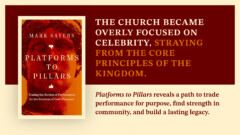This is the first in a series of articles which will examine the various Bible translations available today in the English language. With such a multitude of translations available, Christians are often puzzled as they attempt to discern which one most accurately represents the words of God. In past years many have been told that the New International Version provides the best balance between accuracy and readability, that the New American Standard Bible is the most accurate but is difficult to read and that The Living Bible is the easiest to read, but lacks accuracy. These assumptions may be accurate, but they are simplified. Today major new translations appear at the rate of one every couple of years. While most of them make little impact, some, such as the New Living Translation and The Message have gained widespread acceptance. The NIV, which once was regarded as the standard Bible of evangelical churches, is losing ground and may soon fade to history. And what of the venerable King James Version?
Deciding which translation is best must depend on one’s view of the Bible. A person who regards the Bible merely as human words, or even as the thoughts of God given through human writers will regard the importance of an accurate translation far differently from one who believes that the text of the Bible is the very words of God. This series will be premised on the traditional Protestant view that the Bible is inspired by God, is without error and is the effective, supreme and final authority on matters of life and faith. How do we know this is the case? Quite simply, because the Bible says so. If the Bible is truly authoritative, it stands to reason that it can appeal to no higher authority than itself to prove what it says. Therefore we must accept by faith at face value what the Bible says of itself.
Much could be said about the philosophy of Bible translation. Many books have been written on this topic and I while could devote tens of thousands of words to it, for sake of brevity I will merely summarize some of the most important points. To do so we will examine the three common methods of Bible translation.
Paraphrase (also known as Free Translation) – Paraphrases attempt to translate ideas and concepts from the original text but without being constrained by the original language and words. They also seek to contextualize the Bible to the contemporary culture, eliminating the historical distance between the time the Bible was written and the time in which it is read. This allows them to be easy to read as they do not need to conform to the sentence structures of the original languages. However, they are also less-literal in their translation. The most widely-read paraphrase is The Living Bible, though in recent days The Message has become exceedingly popular.
Dynamic Equivalence (also known as Thought for Thought) – Dynamic equivalency attempts to create a consistent historical distance between the text and the reader so that the text has the same impact on the contemporary reader as it did on the original reader or listener. Because the translation does not need to be constrained to the original language and sentence structures, the text can flow smoothly, allowing it to be easily readable. However, dynamic equivalence requires some degree of interpretation as the translator attempts to discern not only the words of the author but also the author’s intent and meaning. The most popular dynamic equivalent translation is the New International Version.
Formal Equivalence (also known as Word for Word, Literal Translation or Essentially Literal) – Formal equivalence attempts to represent each word of the original language with a corresponding word in the English language. This allows the reader to know, as closely as possible, what God actually spoke through the authors of the Bible. The merit of this method is that it allows intimate access to the originally inspired words for those who do not speak the languages the Bible was written in. The downside is that it is possible for these translations to be awkwardly worded and follow difficult sentence structures. Examples are the New American Standard Bible and the English Standard Version.
Questions about translation
Should we translate meaning or words?
This is a foundational question, as the answer will determine the entire method of translation. If translating meaning is most important, the primary task of the translator is first to determine what the author meant and then translate his interpretation of that meaning. The problem with this is that we may not know what the original author meant. We can guess and make assumptions, even very rational assumptions, but we can not know for certain someone else’s meaning. What we can and do know are the words he used to express meaning and those words can be accurately translated. This separates interpretation and translation. The meaning of a passage cannot be separated from the words, therefore the job of the translator should be to translate those words, not a perceived meaning.
How much interpretation should there be in translation?
Ideally there should be no thematic interpretation in a translation. There must be linguistic translation, such as the proper meaning of a word, but themes should be presented as clearly or as opaquely as they are in the original text.
What are important features in a Bible?
Traditional theological vocabulary. Many theological terms used in the Bible have no accurate English translations. Therefore, many Bibles have chosen to adopt terms such as justification, sanctification and redemption directly from the Scriptures.
Nouns and pronouns. Some Bibles choose to capitalize nouns and pronouns that refer to any member of the Trinity. This makes it easier to understand whether such words refer to God or to someone else.
Words of Christ in red. Some Bibles use red ink for the words of Christ to make it easy to identify when He speaks. Some insist on this feature and others feel it reduces the perceived importance of the rest of the words of the text. I find it a helpful but certainly not necessary feature.
Headers. Many Bibles use descriptive headers at the beginning of each chapter or even throughout chapters to allow readers to identify important sections. Headers are added by translators or editors so are fallible. The doctrinal emphases of the editors or translators will show through these headers which can cause problems.
Cross references. Many Bibles cross reference passages, so that a verse may have a note directing the reader to a similar verse in a different passage. Cross references are very helpful.
Concordance. A Concordance is a list of words and a reference to where they may be found within the Bible. While these are helpful, they are limited because of space considerations. A concordance in a Bible should not replace a full concordance for the serious student of the Word.
Rules of Translation
To summarize, these are what I consider four important rules in translation:
- We must never lose sight of the fact that it is God’s Word that is being translated. These are not the words of fallible men but of a Holy God who is giving these words to direct our lives.
- The text must be translated as accurately and faithfully as possible from the original language to the receptor language.
- The translation must be readable so that it adheres to rules of English vocabulary, syntax and grammar.
- The translation must not seek to bring clarity to what is difficult in the original text. The interpretation must stay separate from the translation.
At this point I hope it is clear what I consider the ideal for a translation of the Scripture. In our next article we will begin to look at specific translations.
If you are interested in reading more about translations and translating, I recommend The Word of God in English by Leland Ryken.










